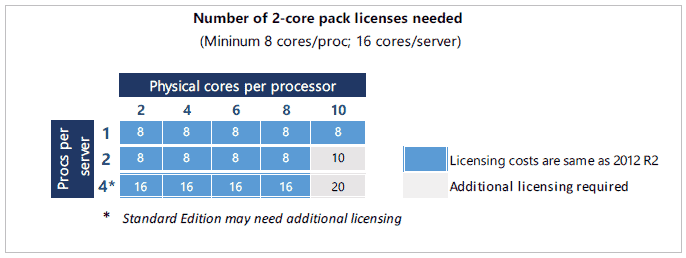
The only constant in the IT industry is that things are always changing. The next major change on the horizon involves a product that is at the core of most company networks: Microsoft Windows Server.
Just a few days ago, the story broke that Microsoft is going to be changing how Windows Server is licensed. Windows Server 2012 is currently licensed per processor. Windows Server 2016 will be licensed per core. This is sure to cause confusion to many customers, so this post will try to help clarify what that means. This post will just focus on the licensing issues; I’ll let the Mirazon engineers address the new technical features of Windows Server 2016.
Continuity: What Stays the Same
- There are still versions of Windows Server: Standard and Datacenter.
- Standard still provides you with the right to create two virtual machines and Datacenter still provides you with the right to create unlimited virtual machines. (For more information, see my posts part one here and part two here.)
- A Client Access License (CAL) is still required for each user or device.
- A Remote Desktop Services CAL (formerly known as a “Terminal Server CAL”) is still an add-on CAL.
Discontinuity: What Is Changing
The biggest change obviously is that Microsoft is shifting from processor-based licensing to core-based licensing. Currently, in Windows Server 2012, if you purchased a Standard license then you would receive permission from Microsoft to install Windows Server on a single physical server with up to 2 processors within the server. For more details on that, see this blog post I wrote last year.
For Windows Server 2016 the rule will be this:
“To license a physical server, all physical cores must be licensed in the server. A minimum of 8 core licenses is required for each physical processor in the server and a minimum of 16 cores is required to be licensed for servers with one processor.”
This definition is from the Windows Server 2016 datasheet. Here’s what it means in plain English:
If you want to license a physical server for Windows Server 2016, at a minimum you will need to buy licensing for 16-cores. This will provide you with the right to install Windows Server on a physical server that contains up to two processors, and each processor can have up to eight cores.
The good news in this is that Microsoft wisely decided not to raise the price for the minimum package. Here’s how things compare between the minimum bundle of 2012 Standard and 2016 Standard:
Windows Server 2012 Standard – Minimum Requirement
1 license covers up to two physical processors (unlimited cores each) in a single server = $882
Windows Server 2016 Standard – Minimum Requirement
16 core-license minimum; covers up to two physical processors (8 cores each) in a single server = $882
In their FAQ document, Microsoft provides the following chart which illustrates the fact that in many situations, there is no price increase between 2012 and 2016:

As you can see from this chart, a price increase only occurs when you are using processors that have more than eight cores. If you are a large corporation, then that may affect you. But if you are a small or medium business, chances are that you are not currently shelling out large amounts of cash to your hardware manufacturer to purchase processors with more than eight cores. As the price of processors comes down, then it’s a possibility for the future, but currently many clients will still fall within the boundaries of the minimum purchase amount.
The other situation where you will need to pay Microsoft more money is if you are using a server that has more than two physical processors. But if that is the case, then you would need buy more than the minimum amount whether you were using 2012 or 2016.
To throw in another level of complexity, Microsoft is only selling core licenses for Windows Server 2016 as two-packs. So for a minimum solution, you will need to purchase eight two-packs, since 8 x 2 = 16.
When we get closer to the release date of Windows Server 2016, I’ll provide a more thorough explanation of how this is going to work. For now, just be aware that change is on the horizon.
For more information, you can consult Microsoft’s datasheet and FAQ document.